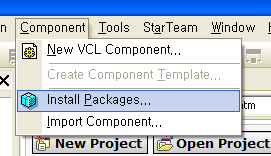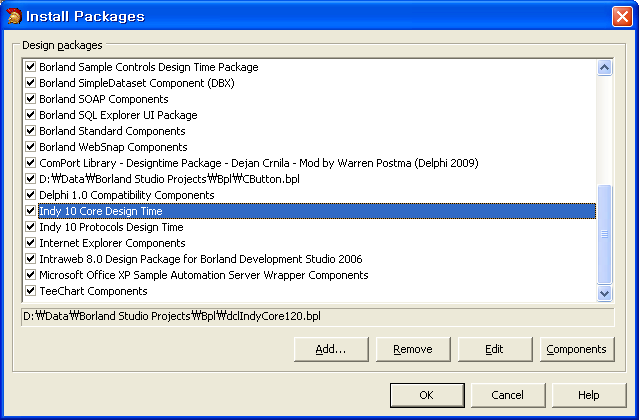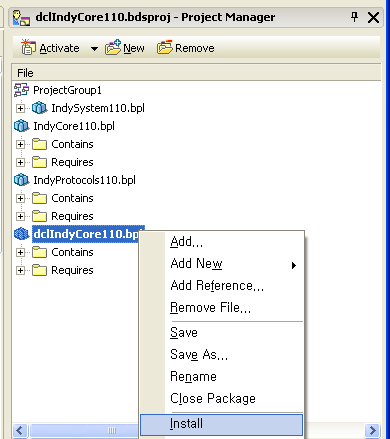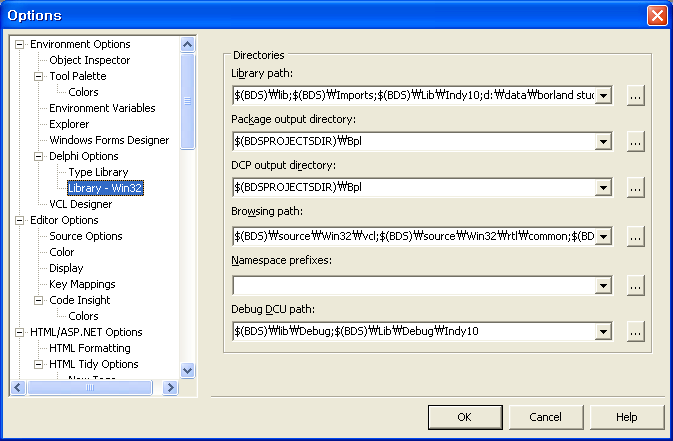1。新建dll项目GetWordDll.dpr,代码如下
library GetWordDll;
uses
Windows,
SysUtils,
Classes,
UnitHookDll in ‘UnitHookDll.pas’,
UnitNt2000Hook in ‘UnitNt2000Hook.pas’,
UnitHookType in ‘UnitHookType.pas’;
exports
StartHook,
StopHook;
// MouseWndProc,
{以下导出列表都是必须的,
不能少,因为程序要取其地址}
{ NewBeginPaint,
NewCreateCompatibleDC,
NewTextOutA,
NewTextOutW,
NewExtTextOutA,
NewExtTextOutW,
NewDrawTextA,
NewDrawTextW; }
begin
end.
2。新建3个单元UnitHookDll.pas,UnitHookType.pas,UnitNt2000Hook.pas具体代码如下
unit UnitHookDll;
interface
uses Windows, SysUtils, Classes, math, messages, dialogs, UnitNt2000Hook,
UnitHookType;
const
COLOR1=255;
COLOR2=0;
COLOR3=255;
Trap=true; //True陷阱式,False表示改引入表式
procedure StartHook; stdcall; {开始取词}
procedure StopHook; stdcall; {停止取词}
implementation
var
MouseHook: THandle;
pShMem: PShareMem;
hMappingFile: THandle;
FirstProcess:boolean;{是否是第一个进程}
Hook: array[fBeginPaint..fDrawTextW] of THookClass;{API HOOK类}
i:integer;
{自定义的BeginPaint}
function NewBeginPaint(Wnd: HWND; var lpPaint: TPaintStruct): HDC; stdcall;
type
TBeginPaint=function (Wnd: HWND; var lpPaint: TPaintStruct): HDC; stdcall;
begin
Hook[fBeginPaint].Restore;
result:=TBeginPaint(Hook[fBeginPaint].OldFunction)(Wnd,lpPaint);
if Wnd=pshmem^.hHookWnd then{如果是当前鼠标的窗口句柄}
begin
pshmem^.DCMouse:=result;{记录它的返回值}
end
else pshmem^.DCMouse:=0;
Hook[fBeginPaint].Change;
end;
{自定义的GetWindowDC}
function NewGetWindowDC(Wnd: HWND): HDC; stdcall;
type
TGetWindowDC=function (Wnd: HWND): HDC; stdcall;
begin
Hook[fGetWindowDC].Restore;
result:=TGetWindowDC(Hook[fGetWindowDC].OldFunction)(Wnd);
if Wnd=pshmem^.hHookWnd then{如果是当前鼠标的窗口句柄}
begin
pshmem^.DCMouse:=result;{记录它的返回值}
end
else pshmem^.DCMouse:=0;
Hook[fGetWindowDC].Change;
end;
{自定义的GetDC}
function NewGetDC(Wnd: HWND): HDC; stdcall;
type
TGetDC=function (Wnd: HWND): HDC; stdcall;
begin
Hook[fGetDC].Restore;
result:=TGetDC(Hook[fGetDC].OldFunction)(Wnd);
if Wnd=pshmem^.hHookWnd then{如果是当前鼠标的窗口句柄}
begin
pshmem^.DCMouse:=result;{记录它的返回值}
end
else pshmem^.DCMouse:=0;
Hook[fGetDC].Change;
end;
{自定义的CreateCompatibleDC}
function NewCreateCompatibleDC(DC: HDC): HDC; stdcall;
type
TCreateCompatibleDC=function (DC: HDC): HDC; stdcall;
begin
Hook[fCreateCompatibleDC].Restore;
result:=TCreateCompatibleDC(Hook[fCreateCompatibleDC].OldFunction)(DC);
if DC=pshmem^.DCMouse then{如果是当前鼠标的窗口HDC}
begin
pshmem^.DCCompatible:=result;{记录它的返回值}
end
else pshmem^.DCCompatible:=0;
Hook[fCreateCompatibleDC].Change;
end;
function NewTextOutA(theDC: HDC; nXStart, nYStart: integer; str: pchar; count: integer): bool;
stdcall;
type
TTextOutA=function (theDC: HDC; nXStart, nYStart: integer; str: pchar; count: integer): bool;stdcall;
var
dwBytes: DWORD;
poOri, poDC, poText, poMouse: TPoint;
Size: TSize;
Rec:TRect;
faint:boolean;
begin
Hook[fTextOutA].Restore;{暂停截取API,恢复被截的函数}
try
if pShMem^.bCanSpyNow then{是否开始取词}
begin
GetDCOrgEx(theDC, poOri);{HDC的坐标}
poDC.x := nXStart;{显示的相对坐标}
poDC.y := nYStart;
if(poOri.X=0)and(poOri.Y=0)then{如果HDC的坐标为(0,0)}
begin
if (theDC=pShmem^.DCCompatible)then
faint:=false{精确匹配,就是指定的内存HDC}
else faint:=true;{模糊匹配,"可能"是内存HDC}
{取鼠标当前处的窗口(等效于Delphi的控件)坐标}
GetWindowRect(pShMem^.hHookWnd,Rec);
poOri.X:=Rec.Left;{把窗口坐标作为HDC的坐标}
poOri.Y:=Rec.Top;
end
else begin{如果是普通HDC}
{局部逻辑坐标转化为设备相关坐标}
LPToDP(theDC, poDC, 1);
faint:=false;{精确匹配,是普通HDC}
end;
{计算显示文字的屏幕坐标}
poText.x := poDC.x + poOri.x;
poText.y := poDC.y + poOri.y;
{获取当前鼠标的坐标}
GetCursorPos(poMouse);
{如果对齐属性是居中}
if (GetTextAlign(theDC) and TA_UPDATECP) <> 0 then
begin
GetCurrentPositionEx(theDC, @poOri);
poText.x := poText.x + poOri.x;
poText.y := poText.y + poOri.y;
end;
{显示文字的长和宽}
GetTextExtentPoint(theDC, Str, Count, Size);
{鼠标是否在文本的范围内}
if (poMouse.x >= poText.x) and (poMouse.x <= poText.x + Size.cx)
and (poMouse.y >= poText.y) and (poMouse.y <= poText.y + Size.cy)
then
begin
{最多取MaxStringLen个字节}
dwBytes := min(Count, MaxStringLen);
{拷贝字符串}
CopyMemory(@(pShMem^.Text), Str, dwBytes);
{以空字符结束}
pShMem^.Text[dwBytes] := Chr(0);
{发送WM_MOUSEPT成功取词的消息给主程序}
postMessage(pShMem^.hProcWnd, WM_MOUSEPT, fTextOutA, 2);
{如果输出的不是Tab键,而且是精确匹配的}
if (string(pShMem^.Text)<>#3)and(not faint) then
pShMem^.bCanSpyNow := False;{取词结束}
end;
end;
finally
{调用被截的函数}
result := TTextOutA(Hook[fTextOutA].OldFunction)(theDC, nXStart,
nYStart, str, count);
end;
Hook[fTextOutA].Change;{重新截取API}
end;
function NewTextOutW(theDC: HDC; nXStart, nYStart: integer; str: pWidechar; count: integer): bool; stdcall;
type
TTextOutW=function (theDC: HDC; nXStart, nYStart: integer; str: pWidechar; count: integer): bool; stdcall;
var
dwBytes: DWORD;
poOri, poDC, poText, poMouse: TPoint;
Size: TSize;
Rec:TRect;
faint:boolean;
begin
Hook[fTextOutW].Restore;{暂停截取API,恢复被截的函数}
// SetTextColor(thedc,RGB(COLOR1,COLOR2,COLOR3));
try
if pShMem^.bCanSpyNow then{是否开始取词}
begin
GetDCOrgEx(theDC, poOri);{HDC的坐标}
poDC.x := nXStart;{显示的相对坐标}
poDC.y := nYStart;
if(poOri.X=0)and(poOri.Y=0)then{如果HDC的坐标为(0,0)}
begin
if (theDC=pShmem^.DCCompatible)then
faint:=false{精确匹配,就是指定的内存HDC}
else faint:=true;{模糊匹配,"可能"是内存HDC}
{取鼠标当前处的窗口(等效于Delphi的控件)坐标}
GetWindowRect(pShMem^.hHookWnd,Rec);
poOri.X:=Rec.Left;{把窗口坐标作为HDC的坐标}
poOri.Y:=Rec.Top;
end
else begin{如果是普通HDC}
{局部逻辑坐标转化为设备相关坐标}
LPToDP(theDC, poDC, 1);
faint:=false;{精确匹配,是普通HDC}
end;
{计算显示文字的屏幕坐标}
poText.x := poDC.x + poOri.x;
poText.y := poDC.y + poOri.y;
{获取当前鼠标的坐标}
GetCursorPos(poMouse);
{如果对齐属性是居中}
if (GetTextAlign(theDC) and TA_UPDATECP) <> 0 then
begin
GetCurrentPositionEx(theDC, @poOri);
poText.x := poText.x + poOri.x;
poText.y := poText.y + poOri.y;
end;
{显示文字的长和宽}
GetTextExtentPointW(theDC, Str, Count, Size);
{鼠标是否在文本的范围内}
if (poMouse.x >= poText.x) and (poMouse.x <= poText.x + Size.cx)
and (poMouse.y >= poText.y) and (poMouse.y <= poText.y + Size.cy)
then
begin
{最多取MaxStringLen个字节}
dwBytes := min(Count*2, MaxStringLen);
{拷贝字符串}
CopyMemory(@(pShMem^.Text), Pchar(WideCharToString(Str)), dwBytes);
{以空字符结束}
pShMem^.Text[dwBytes] := Chr(0);
{发送WM_MOUSEPT成功取词的消息给主程序}
postMessage(pShMem^.hProcWnd, WM_MOUSEPT, fTextOutW, 2);
{如果输出的不是Tab键,而且是精确匹配的}
if (string(pShMem^.Text)<>#3)and(not faint) then
pShMem^.bCanSpyNow := False;{取词结束}
end;
end;
finally
{调用被截的函数}
result := TTextOutW(Hook[fTextOutW].OldFunction)(theDC, nXStart, nYStart, str, Count);
end;
Hook[fTextOutW].Change;{重新截取API}
end;
function NewExtTextOutA(theDC: HDC; nXStart, nYStart: integer; toOptions:Longint;
rect: PRect; Str: PAnsiChar; Count: Longint; Dx: PInteger): BOOL; stdcall;
type
TExtTextOutA=function (theDC: HDC; nXStart, nYStart: integer; toOptions:Longint;
rect: PRect; Str: PAnsiChar; Count: Longint; Dx: PInteger): BOOL; stdcall;
var
dwBytes: DWORD;
poOri, poDC, poText, poMouse: TPoint;
Size: TSize;
Rec:TRect;
faint:boolean;
begin
Hook[fExtTextOutA].Restore;{暂停截取API,恢复被截的函数}
// SetTextColor(thedc,RGB(COLOR1,COLOR2,COLOR3));
try
if pShMem^.bCanSpyNow then{是否开始取词}
begin
GetDCOrgEx(theDC, poOri);{HDC的坐标}
poDC.x := nXStart;{显示的相对坐标}
poDC.y := nYStart;
if(poOri.X=0)and(poOri.Y=0)then{如果HDC的坐标为(0,0)}
begin
if (theDC=pShmem^.DCCompatible)then
faint:=false{精确匹配,就是指定的内存HDC}
else faint:=true;{模糊匹配,"可能"是内存HDC}
{取鼠标当前处的窗口(等效于Delphi的控件)坐标}
GetWindowRect(pShMem^.hHookWnd,Rec);
poOri.X:=Rec.Left;{把窗口坐标作为HDC的坐标}
poOri.Y:=Rec.Top;
end
else begin{如果是普通HDC}
{局部逻辑坐标转化为设备相关坐标}
LPToDP(theDC, poDC, 1);
faint:=false;{精确匹配,是普通HDC}
end;
{计算显示文字的屏幕坐标}
poText.x := poDC.x + poOri.x;
poText.y := poDC.y + poOri.y;
{获取当前鼠标的坐标}
GetCursorPos(poMouse);
{如果对齐属性是居中}
if (GetTextAlign(theDC) and TA_UPDATECP) <> 0 then
begin
GetCurrentPositionEx(theDC, @poOri);
poText.x := poText.x + poOri.x;
poText.y := poText.y + poOri.y;
end;
{显示文字的长和宽}
GetTextExtentPoint(theDC, Str, Count, Size);
{鼠标是否在文本的范围内}
if (poMouse.x >= poText.x) and (poMouse.x <= poText.x + Size.cx)
and (poMouse.y >= poText.y) and (poMouse.y <= poText.y + Size.cy)
then
begin
{最多取MaxStringLen个字节}
dwBytes := min(Count, MaxStringLen);
{拷贝字符串}
CopyMemory(@(pShMem^.Text), Str, dwBytes);
{以空字符结束}
pShMem^.Text[dwBytes] := Chr(0);
{发送WM_MOUSEPT成功取词的消息给主程序}
postMessage(pShMem^.hProcWnd, WM_MOUSEPT, fExtTextOutA, 2);
{如果输出的不是Tab键,而且是精确匹配的}
if (string(pShMem^.Text)<>#3)and(not faint) then
pShMem^.bCanSpyNow := False;{取词结束}
end;
end;
finally
{调用被截的函数}
result := TExtTextOutA(Hook[fExtTextOutA].OldFunction)(theDC, nXStart, nYStart, toOptions, rect, Str,
Count, Dx);
end;
Hook[fExtTextOutA].Change;{重新截取API}
end;
function NewExtTextOutW(theDC: HDC; nXStart, nYStart: integer; toOptions:
Longint; rect: PRect;
Str: Pwidechar; Count: Longint; Dx: PInteger): BOOL; stdcall;
type
TExtTextOutW=function (theDC: HDC; nXStart, nYStart: integer; toOptions:Longint;
rect: PRect; Str: Pwidechar; Count: Longint; Dx: PInteger): BOOL; stdcall;
var
dwBytes: DWORD;
poOri, poDC, poText, poMouse: TPoint;
Size: TSize;
Rec:TRect;
faint:boolean;
begin
Hook[fExtTextOutW].Restore;{暂停截取API,恢复被截的函数}
// SetTextColor(thedc,RGB(COLOR1,COLOR2,COLOR3));
try
if pShMem^.bCanSpyNow then{是否开始取词}
begin
GetDCOrgEx(theDC, poOri);{HDC的坐标}
poDC.x := nXStart;{显示的相对坐标}
poDC.y := nYStart;
if(poOri.X=0)and(poOri.Y=0)then{如果HDC的坐标为(0,0)}
begin
if (theDC=pShmem^.DCCompatible)then
faint:=false{精确匹配,就是指定的内存HDC}
else faint:=true;{模糊匹配,"可能"是内存HDC}
{取鼠标当前处的窗口(等效于Delphi的控件)坐标}
GetWindowRect(pShMem^.hHookWnd,Rec);
poOri.X:=Rec.Left;{把窗口坐标作为HDC的坐标}
poOri.Y:=Rec.Top;
end
else begin{如果是普通HDC}
{局部逻辑坐标转化为设备相关坐标}
LPToDP(theDC, poDC, 1);
faint:=false;{精确匹配,是普通HDC}
end;
{计算显示文字的屏幕坐标}
poText.x := poDC.x + poOri.x;
poText.y := poDC.y + poOri.y;
{获取当前鼠标的坐标}
GetCursorPos(poMouse);
{如果对齐属性是居中}
if (GetTextAlign(theDC) and TA_UPDATECP) <> 0 then
begin
GetCurrentPositionEx(theDC, @poOri);
poText.x := poText.x + poOri.x;
poText.y := poText.y + poOri.y;
end;
{显示文字的长和宽}
GetTextExtentPointW(theDC, Str, Count, Size);
{鼠标是否在文本的范围内}
if (poMouse.x >= poText.x) and (poMouse.x <= poText.x + Size.cx)
and (poMouse.y >= poText.y) and (poMouse.y <= poText.y + Size.cy)
then
begin
{最多取MaxStringLen个字节}
dwBytes := min(Count*2, MaxStringLen);
{拷贝字符串}
CopyMemory(@(pShMem^.Text), Pchar(WideCharToString(Str)), dwBytes);
{以空字符结束}
pShMem^.Text[dwBytes] := Chr(0);
{发送WM_MOUSEPT成功取词的消息给主程序}
postMessage(pShMem^.hProcWnd, WM_MOUSEPT, fExtTextOutW, 2);
{如果输出的不是Tab键,而且是精确匹配的}
if (string(pShMem^.Text)<>#3)and(not faint) then
pShMem^.bCanSpyNow := False;{取词结束}
end;
end;
finally
{调用被截的函数}
result := TExtTextOutW(Hook[fExtTextOutW].OldFunction)(theDC, nXStart, nYStart, toOptions,Rect, Str, Count, Dx);
end;
Hook[fExtTextOutW].Change;{重新截取API}
end;
function NewDrawTextA(theDC: HDC; lpString: PAnsiChar; nCount: Integer;
var lpRect: TRect; uFormat: UINT): Integer; stdcall;
type
TDrawTextA=function (theDC: HDC; lpString: PAnsiChar; nCount: Integer;
var lpRect: TRect; uFormat: UINT): Integer; stdcall;
var
poMouse,poOri,poDC: TPoint;
dwBytes: integer;
RectSave,rec:TRect;
faint:boolean;
begin
Hook[fDrawTextA].Restore;{暂停截取API,恢复被截的函数}
// SetTextColor(thedc,RGB(COLOR1,COLOR2,COLOR3));
try
if pShMem^.bCanSpyNow then{是否开始取词}
begin
GetDCOrgEx(theDC, poOri);{HDC的坐标}
poDC.x := 0;{局部逻辑坐标初始化为(0,0)}
poDC.y := 0;
if(poOri.X=0)and(poOri.Y=0)then{如果HDC的坐标为(0,0)}
begin
if (theDC=pShmem^.DCCompatible)then
faint:=false{精确匹配,就是指定的内存HDC}
else faint:=true;{模糊匹配,"可能"是内存HDC}
{取鼠标当前处的窗口(等效于Delphi的控件)坐标}
GetWindowRect(pShMem^.hHookWnd,Rec);
poOri.X:=Rec.Left;{把窗口坐标作为HDC的坐标}
poOri.Y:=Rec.Top;
end
else begin{如果是普通HDC}
{局部逻辑坐标转化为设备相关坐标}
LPToDP(theDC, poDC, 1);
faint:=false;{精确匹配,是普通HDC}
end;
RectSave := lpRect;{显示的矩形}
OffsetRect(RectSave, poOri.x+poDC.x, poOri.y+poDC.y);{显示的矩形加上偏移}
{获取当前鼠标的坐标}
GetCursorPos(poMouse);
{鼠标是否在文本的范围内}
if PtInRect(RectSave, poMouse) then
begin
if nCount=-1 then
begin
strcopy(@(pShMem^.Text[0]), lpString);
end
else begin
{最多取MaxStringLen个字节}
dwBytes := min(nCount, MaxStringLen);
{拷贝字符串}
CopyMemory(@(pShMem^.Text[0]), lpString, dwBytes);
{以空字符结束}
pShMem^.Text[dwBytes] := Chr(0);
end;
{发送WM_MOUSEPT成功取词的消息给主程序}
postMessage(pShMem^.hProcWnd, WM_MOUSEPT, fDrawTextA, 2);
{如果输出的不是Tab键,而且是精确匹配的}
if (string(pShMem^.Text)<>#3)and(not faint) then
pShMem^.bCanSpyNow := False;{取词结束}
end;
end;
finally
{调用被截的函数}
result := TDrawTextA(Hook[fDrawTextA].OldFunction)(theDC, lpString, nCount, lpRect, uFormat);
end;
Hook[fDrawTextA].Change;{重新截取API}
end;
function NewDrawTextW(theDC: HDC; lpString: PWideChar; nCount: Integer;
var lpRect: TRect; uFormat: UINT): Integer; stdcall;
type
TDrawTextW=function (theDC: HDC; lpString: PWideChar; nCount: Integer;
var lpRect: TRect; uFormat: UINT): Integer; stdcall;
var
poMouse,poOri,poDC: TPoint;
dwBytes: integer;
RectSave,rec:TRect;
faint:boolean;
begin
Hook[fDrawTextW].Restore;{暂停截取API,恢复被截的函数}
// SetTextColor(thedc,RGB(COLOR1,COLOR2,COLOR3));
try
if pShMem^.bCanSpyNow then{是否开始取词}
begin
GetDCOrgEx(theDC, poOri);{HDC的坐标}
poDC.x := 0;{局部逻辑坐标初始化为(0,0)}
poDC.y := 0;
if(poOri.X=0)and(poOri.Y=0)then{如果HDC的坐标为(0,0)}
begin
if (theDC=pShmem^.DCCompatible)then
faint:=false{精确匹配,就是指定的内存HDC}
else faint:=true;{模糊匹配,"可能"是内存HDC}
{取鼠标当前处的窗口(等效于Delphi的控件)坐标}
GetWindowRect(pShMem^.hHookWnd,Rec);
poOri.X:=Rec.Left;{把窗口坐标作为HDC的坐标}
poOri.Y:=Rec.Top;
end
else begin{如果是普通HDC}
{局部逻辑坐标转化为设备相关坐标}
LPToDP(theDC, poDC, 1);
faint:=false;{精确匹配,是普通HDC}
end;
RectSave := lpRect;{显示的矩形}
OffsetRect(RectSave, poOri.x+poDC.x, poOri.y+poDC.y);{显示的矩形加上偏移}
{获取当前鼠标的坐标}
GetCursorPos(poMouse);
{鼠标是否在文本的范围内}
if PtInRect(RectSave, poMouse) then
begin
if nCount=-1 then
begin
strcopy(@(pShMem^.Text[0]), Pchar(WideCharToString(lpString)));
end
else begin
{最多取MaxStringLen个字节}
dwBytes := min(nCount*2, MaxStringLen);
{拷贝字符串}
CopyMemory(@(pShMem^.Text[0]), Pchar(WideCharToString(lpString)), dwBytes);
{以空字符结束}
pShMem^.Text[dwBytes] := Chr(0);
end;
{发送WM_MOUSEPT成功取词的消息给主程序}
postMessage(pShMem^.hProcWnd, WM_MOUSEPT, fDrawTextW, 2);
{如果输出的不是Tab键,而且是精确匹配的}
if (string(pShMem^.Text)<>#3)and(not faint) then
pShMem^.bCanSpyNow := False;{取词结束}
end;
end;
finally
{调用被截的函数}
result := TDrawTextW(Hook[fDrawTextW].OldFunction)(theDC, lpString, nCount, lpRect, uFormat);
end;
Hook[fDrawTextW].Change;{重新截取API}
end;
{遍历所有菜单项}
procedure IterateThroughItems(WND:HWND;menu:Hmenu;p:TPoint;Level:integer);
var
i:integer;
info:TMenuItemInfo;
rec:TRect;
begin
for i:=0 to GetMenuItemCount(menu)-1 do {遍历所有子菜单项}
begin
fillchar(info,sizeof(info),0);
info.cbSize:=sizeof(info);
info.fMask:=MIIM_TYPE or MIIM_SUBMENU;
info.cch:=256;
getmem(info.dwTypeData,256);
{取菜单的文字}
GetMenuItemInfo(menu,i,true,info);
{取菜单的坐标}
GetMenuItemRect(wnd,menu,i,rec);
{如果鼠标在菜单的矩形区域内}
if (rec.Left<=p.X)and(p.X<=rec.Right)and(rec.Top<=p.Y)and(p.Y<=rec.Bottom)then
if (info.cch<>0) then
begin
{取出菜单文字}
strlcopy(pShMem^.Text,info.dwTypeData,min(info.cch,MaxStringLen));
pShMem^.bCanSpyNow := False;
{发送WM_MOUSEPT成功取词的消息给主程序}
PostMessage(pShMem^.hProcWnd, WM_MOUSEPT, fDrawTextW, 2);
end;
// freemem(info.dwTypeData,256);
// info.dwTypeData:=nil;
if info.hSubMenu<>0 then {如果它有下级子菜单,则归递调用}
begin
IterateThroughItems(wnd,info.hSubMenu,p,Level+1);
end;
end;
end;
{定时器,每10毫秒被调用一次}
procedure fOnTimer(theWnd: HWND; msg, idTimer: Cardinal; dwTime: DWORD); stdcall;
var
InvalidRect: TRECT;
buffer:array[0..256]of char;
menu:Hmenu;
MousePoint:TPoint;
begin
pShMem^.nTimePassed := pShMem^.nTimePassed + 1;
if pShMem^.nTimePassed = 10 then {如果鼠标停留了0.1秒}
begin
MousePoint:=pshmem^.pMouse;
{获取当前鼠标所在的窗口(等效于Delphi的控件)句柄}
pshmem^.hHookWnd := WindowFromPoint(MousePoint);
{屏幕坐标转换为窗口(等效于Delphi的控件)客户区的坐标}
ScreenToClient(pshmem^.hHookWnd, MousePoint);
pShMem^.bCanSpyNow := true;{可以开始取词}
{如果客户区的坐标为负值,则说明鼠标位于菜单或标题的上空}
if(MousePoint.x<0)or(MousePoint.y<0) then
begin
{读取并设置标题,让其重绘}
Getwindowtext(pshmem^.hHookWnd,buffer,sizeof(buffer)-1);
Setwindowtext(pshmem^.hHookWnd,pchar(string(buffer)+’ ‘));
Setwindowtext(pshmem^.hHookWnd,buffer);
{客户区的坐标恢复为屏幕坐标}
ClientToScreen(pshmem^.hHookWnd, MousePoint);
{取出当前的菜单}
menu:=GetMenu(pshmem^.hHookWnd);
if menu<>0 then
{遍历所有菜单,判断是否位于鼠标的下方}
IterateThroughItems(pshmem^.hHookWnd,menu,MousePoint,1);
end
else begin{否则,说明鼠标位于客户区}
InvalidRect.left := MousePoint.x;
InvalidRect.top := MousePoint.y;
InvalidRect.Right := MousePoint.x + 1;
InvalidRect.Bottom := MousePoint.y + 1;
{重绘客户区}
InvalidateRect(pshmem^.hHookWnd, @InvalidRect, false);
end;
end
else if pShMem^.nTimePassed >= 11 then
begin
pShMem^.nTimePassed := 11;
end;
{清空pShmem}
end;
{鼠标钩子}
function MouseHookProc(nCode: integer; wPar: WParam; lPar: LParam): lResult;
stdcall;
var
pMouseInf: TMouseHookStruct;
begin
pShMem^.nTimePassed := 0;
if (nCode >= 0) and ((wPar = WM_MOUSEMOVE)or(wPar = WM_NCMOUSEMOVE)) then
begin
pMouseInf := (PMouseHookStruct(lPar))^;
if (pShMem^.pMouse.x <> pMouseInf.pt.x) or
(pShMem^.pMouse.y <> pMouseInf.pt.y) then
begin
if nCode = HC_NOREMOVE then
pShMem^.fStrMouseQueue := ‘Not removed from the queue’
else
pShMem^.fStrMouseQueue := ‘Removed from the queue’;
{鼠标的坐标}
pShMem^.pMouse := pMouseInf.pt;
{鼠标所在的窗口}
pShMem^.hHookWnd := pMouseInf.hwnd;
{1是自定义的数值,表明这是鼠标消息}
postMessage(pShMem^.hProcWnd, WM_MOUSEPT, 1, 1);
end;
end;
Result := CallNextHookEx(MouseHook, nCode, wPar, lPar);
end;
{开始取词}
procedure StartHook; stdcall;
begin
if MouseHook=0 then
begin
pShMem^.fTimerID := SetTimer(0, 0, 10, @fOnTimer);
{注入其它进程}
MouseHook := SetWindowsHookEx(WH_MOUSE, MouseHookProc, HInstance, 0);
end;
end;
{停止取词}
procedure StopHook; stdcall;
begin
if MouseHook<>0 then
begin
KillTimer(0, pShMem^.fTimerID);
UnhookWindowsHookEx(MouseHook);
MouseHook:=0;
end;
end;
initialization
hMappingFile := OpenFileMapping(FILE_MAP_WRITE,False,MappingFileName);
if hMappingFile=0 then
begin
hMappingFile := CreateFileMapping($FFFFFFFF,nil,PAGE_READWRITE,0,SizeOf(TShareMem),MappingFileName);
FirstProcess:=true; {这是第一个进程,即主程序}
end
else FirstProcess:=false;
if hMappingFile=0 then Exception.Create(‘不能建立共享内存!’);
pShMem := MapViewOfFile(hMappingFile,FILE_MAP_WRITE or FILE_MAP_READ,0,0,0);
if pShMem = nil then
begin
CloseHandle(hMappingFile);
Exception.Create(‘不能映射共享内存!’);
end;
if FirstProcess then
begin
pShMem^.bCanSpyNow:=false;
end;
Hook[fBeginPaint]:=THookClass.Create(Trap,@BeginPaint,@NewBeginPaint);{Trap=True陷阱式}
Hook[fGetWindowDC]:=THookClass.Create(Trap,@GetWindowDC,@NewGetWindowDC);
Hook[fGetDC]:=THookClass.Create(Trap,@GetDC,@NewGetDC);
Hook[fCreateCompatibleDC]:=THookClass.Create(Trap,@CreateCompatibleDC,@NewCreateCompatibleDC);
Hook[fTextOutA]:=THookClass.Create(Trap,@TextOutA,@NewTextOutA);
Hook[fTextOutW]:=THookClass.Create(Trap,@TextOutW,@NewTextOutW);
Hook[fExtTextOutA]:=THookClass.Create(Trap,@ExtTextOutA,@NewExtTextOutA);
Hook[fExtTextOutW]:=THookClass.Create(Trap,@ExtTextOutW,@NewExtTextOutW);
Hook[fDrawTextA]:=THookClass.Create(Trap,@DrawTextA,@NewDrawTextA);
Hook[fDrawTextW]:=THookClass.Create(Trap,@DrawTextW,@NewDrawTextW);
finalization
for i:=Low(hook) to High(hook) do
if Hook[i]<>nil then
Hook[i].Destroy;
UnMapViewOfFile(pShMem); {取消映射视图}
CloseHandle(hMappingFile); {关闭映射文件句柄}
end.
UnitHookDll.pas (2)
//-----------------------------------------------------------------------------------
主窗体单元UnitMain.pas
unit UnitMain;
interface
uses
Windows, Messages, SysUtils, Classes, Graphics, Controls, Forms, Dialogs,
StdCtrls,UnitHookType, ExtCtrls;
type
TForm1 = class(TForm)
Button1: TButton;
Label1: TLabel;
Label2: TLabel;
Label3: TLabel;
Edit1: TEdit;
Edit2: TEdit;
Edit3: TEdit;
procedure Button1Click(Sender: TObject);
procedure FormClose(Sender: TObject; var Action: TCloseAction);
procedure FormCreate(Sender: TObject);
private
procedure getMouseInfo(var theMess:TMessage); message WM_MOUSEPT;{处理WM_MOUSEPT}
private
hMapObj : THandle;
pShMem : PShareMem;
fWndClosed:boolean;{是否正在退出主程序}
{ Private declarations }
public
{ Public declarations }
end;
// {未公开的函数,实现隐浮窗口}
// procedure SwitchToThisWindow(wnd:Hwnd;Switch:BOOL);stdcall;external 'user32.dll';
procedure StartHook; stdcall; external 'GetWordDll.DLL';
procedure StopHook; stdcall; external 'GetWordDll.DLL';
var
Form1: TForm1;
implementation
{$R *.DFM}
procedure TForm1.Button1Click(Sender: TObject);
begin
if button1.caption='取词' then
begin
StartHook;
button1.caption:='停止';
end
else begin
StopHook;
button1.caption:='取词';
end;
end;
const
StrProcNames : array[fTextOutA..fDrawTextW] of String =
('来自TextOutA',
'来自TextOutW',
'来自ExtTextOutA',
'来自ExtTextOutW',
'来自DrawTextA',
'来自菜单(来自DrawTextW)'
);
procedure TForm1.getMouseInfo(var theMess : TMessage);
begin
if fWndClosed then
Exit;
//if theMess.Msg=WM_MOUSEPT then showmessage('fff');
if theMess.LParam = 1 then{显示鼠标位置}
edit1.Text := 'X:' + IntToStr(pShMem^.pMouse.x) + ' ' +
'Y:' + IntToStr(pShMem^.pMouse.y) + ' ' +
'HWND:0x' + IntToHex(pShMem^.hHookWnd, 8) + ' ' +
pShMem^.fStrMouseQueue
else if theMess.LParam = 2 then
begin
edit2.Text := pShMem^.Text;
if (theMess.WParam>=4)and(theMess.WParam<=9) then
edit3.Text :=StrProcNames[theMess.Wparam-4];
end;
end;
procedure TForm1.FormClose(Sender: TObject; var Action: TCloseAction);
begin
fWndClosed := True;{正在退出主程序}
if button1.caption<>'取词' then
Button1Click(sender);
end;
procedure TForm1.FormCreate(Sender: TObject);
begin
SetForegroundWindow(self.Handle);{实现隐浮窗口}
hMapObj := OpenFileMapping(FILE_MAP_WRITE,{获取完全访问映射文件}
False,{不可继承的}
LPCTSTR(MappingFileName));{映射文件名字}
if hMapObj = 0 then
begin
ShowMessage('不能定位内存映射文件块!');
Halt;
end;
pShMem := MapViewOfFile(hMapObj,FILE_MAP_WRITE,0,0,0);
if pShMem = nil then
begin
ShowMessage('映射文件错误'+ IntToStr(GetLastError));
CloseHandle(hMapObj);
Halt;
end;
FillChar(pShMem^, SizeOf(TShareMem), 0);
pShMem^.hProcWnd := Self.Handle;
fWndClosed:=false;
end;
end.









